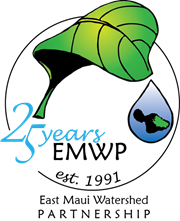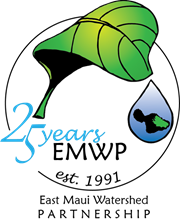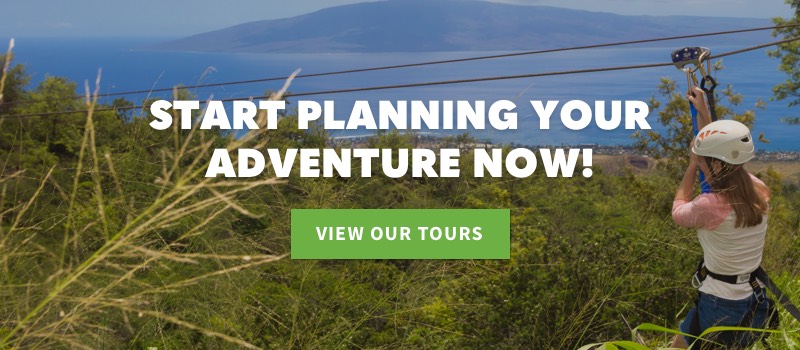February Organization of the Month East Maui Watershed Partnership

 Every month in 2017 Skyline will be featuring a different Hawaii organization. Not only will we help educate our audience about background of the organization and the good things they are up, but we will also inform you how you can get involved to help make a difference! If you are off-island or choose to help in a financial way we will also provide an option for guests to donate a small portion to the monthly org upon booking your upcoming zipline tour!
Every month in 2017 Skyline will be featuring a different Hawaii organization. Not only will we help educate our audience about background of the organization and the good things they are up, but we will also inform you how you can get involved to help make a difference! If you are off-island or choose to help in a financial way we will also provide an option for guests to donate a small portion to the monthly org upon booking your upcoming zipline tour!
February – We Chose East Maui Watershed Partnership (EMWP)
Mission: "The overall mission of EMWP is to protect the Watershed from degradation by protecting native forests and their component native species as well as educating the local community about conservation and other issues relating to watershed protection."
Background
East Maui Watershed (EMW) helps to ensure that Maui’s residents have a clean source of water for domestic, commercial and agricultural uses for this and future generations. EMW includes approximately 100,000 acres of rainforest on the windward slopes of Haleakalā. This watershed produces an average of 60 billion gallons per year for Maui’s agricultural industry, residents and farmers. That’s a lot of water! In fact, it is the largest single source of surface water in the state of Hawaii. A native forested watershed is known to be the most efficient and clean collector and distributor of surface water on the islands. Therefore, protection of the native forest not only protects habitat for rare and endangered species, but also provides Maui with a clean and renewable source of fresh water.
Why Protect It?
Water – Our bodies are made up of 66% water. Water is an essential nutrient that is involved with every function of the body. We need water to grow the food that we eat. Simply put, water is the source of life, and a watershed that protects our water is the key to life.
Native Species and Ecosystems – The watershed comprises some of Hawaii’s richest remaining native forest that is habitat for the world’s greatest concentration of endangered birds, as well as several plant and invertebrate species found nowhere else in the world.
Culture – The native forest is of great cultural significance as the home of plants and animals important in Hawaiian culture and of folklore and traditions based on ancient relationships with the land.
Threats
FACT: The Hawaiian islands went from one new species arriving every 10,000 years…to one arriving every few days! MIND BLOWING!
- Plants – Non-native invasive plants have a variety of impacts to Hawaii’s natural ecosystem.
- Animals – Prey on and compete with native wildlife. Cause erosion and spread invasive species.
- Invertebrates – Small and difficult to control.
- Wildfire – HawaiÊ»i’s ecosystems are not adapted to fire.
- Human Action – We can cause damage too.
For a full list of Hawaii’s Invasive Species or to report and invasive species please contact Maui Invasive Species Committee (MISC) at (808)573-MISC(6472) or go their website www.hawaiiinvasivespecies.org
What Can We Do?
- Fence it! – Most effective way to reduce damage by ungulates in conservation areas
- Remove invasive species from fenced area – Removal of both flora and fauna
- Restore it – Reintroduce native flora and fauna to the area that have been lost
- Manage it – Persistent action is needed to sustain a healthy ecosystem with various threats surrounding it
Significant Progress
Since 1991, the partner agencies and staff of EMWP have:
- Constructed over 7 miles of fence in the remote areas of the watershed
- Implemented a hunting program to increase access for hunters
- Developed a monitoring and management plan
- Initiated animal control and invasive plant species programs above the fence lines
More EMWP Facts
- EMWP currently protects Maui’s largest intact native ecosystem: 100,000 acres of rainforest on the windward slopes of Haleakalā.
- Created in 1991, EMWP inspired the formation of 10 other watershed partnerships that exist throughout the State of Hawaii.
- EMWP consists of 6 partners who all work together to accomplish large scale conservation work that crosses multiple boundaries. These include County of Maui, East Maui Irrigation, Haleakala Ranch, Haleakala National Park, State of Hawaii Department of Land and Natural Resources, and The Nature Conservancy.
- Approximately 40,000 acres of the 100,000 acres of partnership lands are fenced and being actively managed.
- East Maui Watershed is home to over 40 rare plant species and 11 native birds.
- 75% of Maui's native habitat has been lost with most of that below 2500 ft elevation.
- 90% of Hawaii's native flora is endemic, existing nowhere else in the world.
- Native Hawaiian rainforests can increase water capture by up to 50% more than rainfall alone.
- The biggest threat to our native rainforests are invasive species.
How You Can Get Involved
Fund – You can make a tax-deductible donation to support EMWP’s efforts when booking your Skyline zipline tour or by visiting their Donation page. Career – There are several places to get involved in environmental work on Maui at the State, Federal, and non-profit level. Adopt a Fence – With the adopt a fence program your name will be honored with a plaque hung on one of EMWP’s fences.
Volunteer – We rely on the help of individuals with wide variety of interests, skills, and availability. Most volunteer opportunities range from helping to do field work to office work. East Maui Watershed Partnership does not currently have it’s own volunteer program.
Please check out check out Hear.org for other volunteer opportunities. Training for Tour Guides – Due to support from the Hawaii Tourism Authority East Maui Watershed Partnership, Maui Invasive Species Committee and Maui Forest Bird Recovery Project have created a pilot program to help provide Maui tour guides with an effective way to communicate information about the species and environments they are working to protect.
Follow Along – Stay informed on the latest watershed news by subscribing to their free e-mail updates and event announcements. Just contact them with your e-mail and name to “stay in the loop”. Also “Like” their Facebook page and follow them on Twitter. 